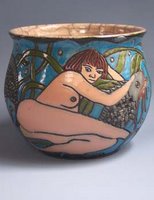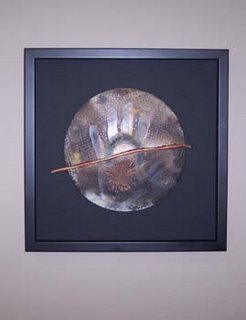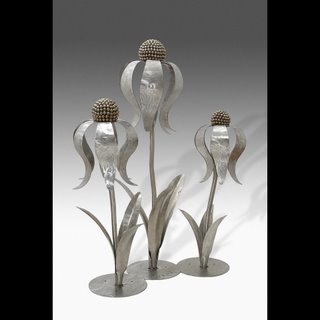
"When I was in college, earning a BFA degree in art, I asked one of the professors why he made art. Waiting in anticipation of his answer, I was expecting some deep philosophical reasons. I will never forget his answer. He said, “I make art because I like to make art.” Over the years I have come to realize that his answer was a deep and insightful reason to create art. I make art because I like to. I believe God made people in His image. God is creative and thus, we are creative."
Kurtis Thomas was born on 3/26/55 in Fresno, California, and has resided in Mobile since the age of ten. He lives with his wife Brenda, daughter Karen, and three cats. He received his BFA from the University of South Alabama in 1977 with a major in commercial art and minor in painting. He then spent several years as advertising art director for a chain of regional home centers. In 1981 Thomas began to exhibit his artwork as a professional artist. His artwork has been shown at reputable galleries and juried art shows across the country. He has work in private and corporate collections in the United States, Japan, England, Australia, and Canada. He has received many awards and prizes for his artwork.
In 2001, Thomas had the opportunity to join the curatorial staff at the newly renovated Mobile Museum of Art. After serving as an art exhibition technician, Thomas became the head registrar at the museum.
Thomas is proficient in drawing and painting in all types of mediums, but his public reputation is built on the fine quality serigraphs he has created by hand since 1981.
"Serigraphy... requires one to think in terms of mass and color instead of just thinking linear. "
Serigraphy, or silkscreen printing, is a stenciling technique which produces fine art, limited edition prints which are signed and numbered by the artist. From the initial idea to the drawing, making the stencils, to hand application of the ink to paper, Thomas performs each step of the process by hand. After completion of an edition, all stencils for that edition are destroyed. This ensures that each print is truly a unique, limited edition piece of art. In today's age of automated technology and photomechanical reproduction, this kind of fine art printing created entirely by the artist has truly become a rarity.
 Thomas has an imaginative style and unusual, delightful perspective that can place ordinary (or not-so-ordinary) subjects in a world just a few steps removed from reality. These walks into the "looking glass" are always composed with a serious eye for the best design possible, and may require from 20 to 80 stencils.
Thomas has an imaginative style and unusual, delightful perspective that can place ordinary (or not-so-ordinary) subjects in a world just a few steps removed from reality. These walks into the "looking glass" are always composed with a serious eye for the best design possible, and may require from 20 to 80 stencils.While most silkscreen artists use only a few stencils with large areas of flat color, Thomas strives for texture, form, value and a wide range of colors achieved only by the use of multiple stencils and stenciling techniques. This results in a true "painterly" effect, and over the years has given him the reputation of a master in his field.
Subject matter includes landscapes, water scenes, birds, houses, flowers, fish, cats, and the Christmas story. His whimsical cat prints get the most vocal response from viewers, as almost everyone recognizes his own feline companion in at least one. But his Christmas prints have also attracted a large following of collectors. In 1981, Thomas created his first Christmas silkscreen print, "O Night Divine," which depicted Mary and Joseph traveling through a snowy forest at night on the way to Bethlehem. He created from one to three new Christmas prints annually through the year 2000, always basing them on the Biblical story of Christ's birth.
Kurtis Thomas has a personal goal of always doing the very best work possible while looking for new ways to grow and new subjects to explore. He feels his work has improved by studying several artists he admires, such as Thomas Hart Benton, Albert Pinkham Ryder, Henri Rousseau and Paul Klee.
 He has often been recognized for his unique mastery of the silkscreen medium, but says, "While the recognition and awards are nice, I think the most important things to me are my own personal satisfaction in the work, achieving the standards I set for myself, and the enjoyment of the people who buy the work and look at it every day. They are telling me they want quality work and appreciate it, and that means a lot to me."
He has often been recognized for his unique mastery of the silkscreen medium, but says, "While the recognition and awards are nice, I think the most important things to me are my own personal satisfaction in the work, achieving the standards I set for myself, and the enjoyment of the people who buy the work and look at it every day. They are telling me they want quality work and appreciate it, and that means a lot to me."
 Charles Smith is a well-known and well-liked Mobile, AL, potter who began his career in the early 1970’s: “I began studying art after a tour of duty in Vietnam, the trauma surrounding the war made me want to pursue the arts.”
Charles Smith is a well-known and well-liked Mobile, AL, potter who began his career in the early 1970’s: “I began studying art after a tour of duty in Vietnam, the trauma surrounding the war made me want to pursue the arts.”














 by harvesters of lumber and pulp. Even firewood gatherers disdain the pieces that I routinely seek. The odd shaped, unwieldy, chunks that won’t split and won’t stack and won’t fit in the fireplace - these are the treasures to which I am attentive, and which come under my hand.
by harvesters of lumber and pulp. Even firewood gatherers disdain the pieces that I routinely seek. The odd shaped, unwieldy, chunks that won’t split and won’t stack and won’t fit in the fireplace - these are the treasures to which I am attentive, and which come under my hand. My wood yards are the log jambs and the swamps of our coastal rivers. Magnolia and Holly and the roots and burls of Eastern White Cedar, Swamp Gum and Oak are abundantly available. Hurricane debris is another of my sources, delivered on a regular basis here on the Gulf Coast. When I weary of working with local woods, I gather a pick-up truck- load of choice pieces and journey to the Carolinas to barter with other wood turners for Maple and Cherry burl, or to Texas to swap for Mesquite.
My wood yards are the log jambs and the swamps of our coastal rivers. Magnolia and Holly and the roots and burls of Eastern White Cedar, Swamp Gum and Oak are abundantly available. Hurricane debris is another of my sources, delivered on a regular basis here on the Gulf Coast. When I weary of working with local woods, I gather a pick-up truck- load of choice pieces and journey to the Carolinas to barter with other wood turners for Maple and Cherry burl, or to Texas to swap for Mesquite. physically and spiritually - than the relationship of my hands and eyes to the spinning workpiece.
physically and spiritually - than the relationship of my hands and eyes to the spinning workpiece. Working with clay has been a love of Lowell's since his childhood. He first discovered clay on his own when he was about 5, while playing near his family's home in Fort Walton, Florida. When he was about 11, he happened to see a folk potter giving a throwing demonstration at a local shopping mall.
Working with clay has been a love of Lowell's since his childhood. He first discovered clay on his own when he was about 5, while playing near his family's home in Fort Walton, Florida. When he was about 11, he happened to see a folk potter giving a throwing demonstration at a local shopping mall. 
















